Summary
The lower productivity of reared pheasants (Phasianus colchicus) compared to their wild counterparts is well documented. Providing supplementary food for pheasants throughout the spring has been shown to increase their breeding success, primarily through improving hen body condition. In a separate study, individually dosing hens with an anthelminthic in spring to reduce their parasitic worm burden has also been shown to increase their productivity in the wild. In a small-scale pilot study these two techniques were combined to test their efficacy as a means of treating free-living pheasants in spring without the need to catch individuals. The parasitic worms recorded wereHeterakis gallinarum andCapillaria spp., both of which are found in the caecae. The results indicated that, in the absence of anthelminthic treatment, worm burden in pheasants increased rapidly between March and April, but in contrast, birds given anthelminthic treated grain had significantly lower worm burden during the same period. Therefore we suggest that this is an effective management technique for treating freeliving pheasants in spring. Subsequently, an experiment was carried out to try to assess the best time to allow pheasants access to ‘treated’ grain in the wild in order to maximise its benefits. Hen pheasants in pens were exposed to infection from the soil. Specific groups of hens were ‘dosed’ at three weekly intervals with anthelminthic treated food and their worm burdens recorded when they were killed at various times thereafter. The results were not clear cut, but suggested that dosing as late as possible prior to nesting would be most beneficial to the hens.
Zusammenfassung
Die geringere Produktivität gezüchteter Fasanen (Phasianus colchicus) im Vergleich zu wild lebenden ist gut belegt. Durch Fütterung von Fasanen im Frühjahr wurde der Bruterfolg erhöht, hauptsächlich wegen der verbesserten körperlichen Kondition der Hennen. Eine weitere Studie ergab, dass die individuelle Behandlung von Hennen mit Anthelminthika, mit dem Ziel einer Reduktion der Wurmbürde, ebenfalls den Fortpflanzungserfolg steigerte. In einer kleinräumigen Pilotstudie wurden diese beiden Methoden kombiniert, um ihre Wirksamkeit für die Behandlung frei lebender Fasane im Frühjahr, ohne die Notwendigkeit des Fangs der Tiere, zu prüfen. Als parasitische Würmer wurden im BlinddarmHeterakis gallinarum undCapillaria spp. nachgewiesen. Die Ergebnisse zeigten, dass ohne Anthelminthika-Behandlung die Wurmbürde der Fasane zwischen März und April deutlich zunahm. Im Gegensatz dazu, wiesen Fasanen, die mit Anthelminthika-behandeltem Getreide gefüttert worden waren, im gleichen Zeitraum eine signifikant niedrigere Wurmbürde auf. Wir empfehlen diese Methode daher als wirksames Verfahren zur Behandlung frei lebender Fasane im Frühjahr. In einem nachfolgenden Experiment wurde versucht, den optimalen Zeitpunkt für die Darreichung von behandeltem Futter im Freiland zu ermitteln. Dazu wurden Fasanenhennen im Gehege einer Wurminfektion über den Boden ausgesetzt. Einzelnen Gruppen von Hennen wurde in dreiwöchigen Abständen Anthelminthika-behandeltes Futter verabreicht. Die Tiere wurden anschlie\end zu verschiedenen Zeitpunkten getötet und ihre Wurmbürde bestimmt. Die Ergebnisse waren nicht eindeutig, deuteten aber darauf hin, dass die Verabreichung des behandelten Futters so kurz wie möglich vor Beginn der Nistzeit am günstigsten für die Hennen ist.
Similar content being viewed by others
References
Alexander, J., Simson, W.H., 1988: Sex hormones and the course of parasitic infection. Parasitology Today4: 189–193.
Brittas, R., Marcstrom, V., Kenward, R.E., Karlbom, M., 1992: Survival and breeding success of reared and wild ring-necked pheasants in Sweden. J. Wildl. Manage56(2): 368–376.
Clapham, P.A., 1934: Experimental studies on the transmission of gapeworm (Syngamus trachea) by earthworms. Proc. Royal Soc.115: 18–30.
Clapham, P.A., 1950: On sterilising land against poultry parasites. J.Helminth.24(3): 137–144.
Doster, G.L.,Goater, C.P., 1997: Collection and quantification of avian helminths and protozoa. In:Clayton, D.H.,Moore, J. (eds.) Host-parasite evolution — General principles and avian models. Oxford University Press. pp 396–418.
Draycott, R.A.H., Hoodless, A.N., Ludiman, M.N., Robertson, P.A., 1998: Effects of spring feeding on body condition of captive-reared ring-necked pheasants in Great Britain. J.Wild.Manage62 (2): 557–563.
Grossman, C.J., 1990: Are there underlying immune-neuroendocrine interactions responsible for immunological sexual dimorphism? Progress in NeuroEndocrinImmunology,3, 75–82.
Hill, D.A., Robertson, P.A., 1988: Breeding success of wild and hand-reared ring-necked pheasants. J. Wildl. Manage.52(3): 446–450.
Hillgarth, N.,Wingfield, J.C., 1997: Parasite-mediated sexual selection: endocrine aspects. In:Clayton, D.H.,Moore, J. (eds.) Host-parasite evolution — General principles and avian models. Oxford University Press. pp 78–104.
Hudson, P.J., Newborn, D., Dobsson, A.P., 1992: Regulation and stability of a free-living host-parasite system:Trichostrongylus tennis in red grouse. I: Monitoring and parasite reduction experiments. J. Anim. Ecol.61: 477–486.
Leif, A.P., 1994: Survival and reproduction of wild and pen-reared ring-necked pheasant hens. J. Wildl. Manage.58(3): 501–506.
Moller, A.P., Christe, P., Erritzoe, J., Mavarez, J., 1998: Condition, disease and immune defence. Oikos83: 301–306.
PapEschi A., Briganti, F., Mugnai, T., Dessi'-Fulgheri, F., 1999: Effect of testosterone on male traits and behaviour in juvenile pheasants. Ethol., Ecol. & Evolut.11(2): 171–178.
Woodburn, M.I.A., 1999: Comparative population dynamics of wild and reared pheasants (Phasianus colchicus). Unpubl. PhD. Thesis, Uni. of Southampton, UK, 237 p.
Author information
Authors and Affiliations
Rights and permissions
About this article
Cite this article
Woodburn, M.I.A., Sage, R.B. & Carroll, J.P. The efficacy of a technique to control parasitic worm burden in pheasants (Phasianus colchicus) in the wild. Zeitschrift für Jagdwissenschaft 48 (Suppl 1), 364–372 (2002). https://doi.org/10.1007/BF02192429
Issue Date:
DOI: https://doi.org/10.1007/BF02192429
Key words
- Pheasant
- Phasianus colchicus
- Heterakis gallinarum
- Capillaria spp.
- Gamebird management
- Anthelminthic
- United Kingdom



